This article was published in Scientific American’s former blog network and reflects the views of the author, not necessarily those of Scientific American
You plan a voyage of exploration for more than three years and the moment comes when you see a new world for the first time.This is an informal sketch of how I experienced this during the encounter of Ultima Thule by NASA’s New Horizons spacecraft. The setting is a simple conference room on New Year’s Day 2019 within building 200 on the campus of the Johns Hopkins University’s Applied Physics Laboratory, which operates New Horizons. The room supports the analysis activities of the Geophysics and Geology Investigations team of New Horizons, one of three divisions of the overall science team established to investigate Ultima Thule. The other science divisions are hosted in similar rooms elsewhere in building 200. Other buildings at APL host the two navigation teams, the operations team, a diverse set of instrument and spacecraft engineers, and a variety of management and support personnel that make it possible for over 100 people to blend their efforts into common cause. Alan Stern is the principal investigator and responsible for the mission overall.
It took all of us to make the encounter happen. Each of us has a story to tell, a part to play, a unique perspective. The credit for success goes to far, far more people than are shown in the pictures in this article, let alone the few who I call out in the narrative. In the end, however, the experience of the encounter is always personal—where you where, what you were doing at the time, who you were with and the shared reactions of those on the team with whom you worked most closely. This story is simply what I saw from the vantage point of the small part of the team that I happened to be with at the time.
The arrival of the first high-resolution image of Ultima Thule in physical terms could be more mundane.
On supporting science journalism
If you're enjoying this article, consider supporting our award-winning journalism by subscribing. By purchasing a subscription you are helping to ensure the future of impactful stories about the discoveries and ideas shaping our world today.
In emotional terms, it could not be more electric.
The Deep Space Network has spent an hour capturing the telemetry from the New Horizons spacecraft, all while sending the image line by line to a server and reduction pipeline in Boulder, Colorado. We wait, check, wait some more for a particular file to build up in a particular directory. Who actually sees the image first comes down to who spots the key file update first—or is the fastest typist.
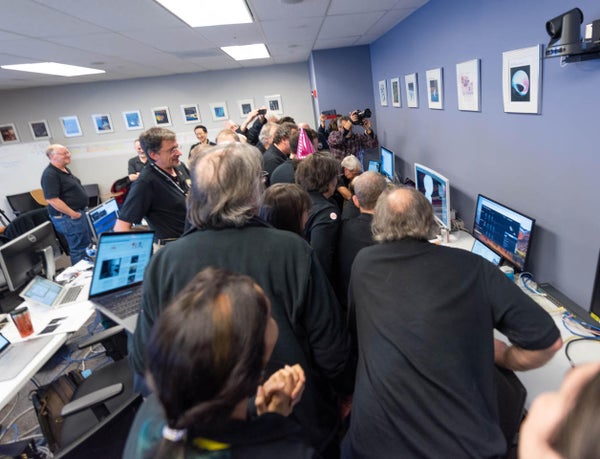
Credit: NASA, JHUAPL, SwRI and Henry Throop
It’s Stuart Robbins who finally shouts: "Got it!" and we immediately mob his work area in the rear of our analysis room. That's my back in the lower right of the image above. I can’t see a damn thing! I doubt that many of us can. We have a huge display in the front of the room, so then the question is: how fast can Stuart remember how to type the command to link up to it?
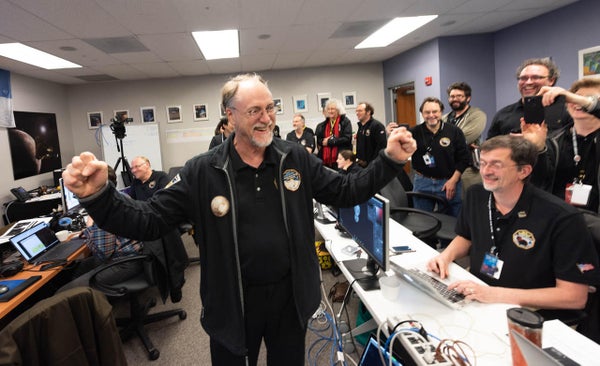
Credit: NASA, JHUAPL, SwRI and Henry Throop
We get the image on screen and everyone goes nuts. That's Marc Buie taking a victory lap, above. Marc was the one who discovered Ultima Thule in the first place, and with immense skill, focus, determination, blood, sweat (and tears for that matter), waged a four-year campaign, enlisting fellow team members (and others) to throw everything they had at the object to determine its precise path through space. Thread a needle while flying out to the galaxy at—let's see—only 42 times the speed of sound. There was never a spacecraft that needed such precise navigation until now.
Oh—hey look, that's Brian May standing in the back. He walked in about 30 seconds before the room exploded with three years of pent-up energy. It’s showtime, except we’re all on stage now. We’re all in the zone. All of us have our parts and instruments to play, but always with attention to each other as we listen to where the music is going. See the people with their hands on their keyboards? They're not getting back to work, they're not calming down from the spectacle. They've started the beat, and we will jam into the night. A quick initial read on Ultima Thule is the task in front of us. Everyone contributes. I look around the room at one point and see Brian quietly working with another team member on using stereo imaging to visualize Ultima Thule.
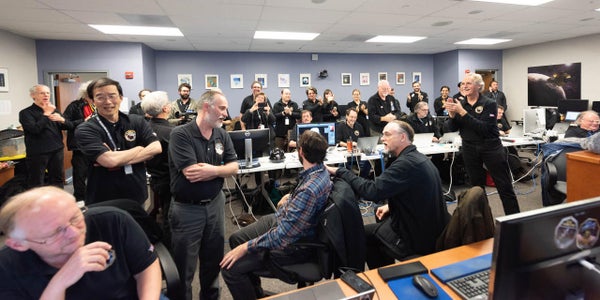
Credit: NASA, JHUAPL, SwRI and Henry Throop
But first John Spencer has a solo. That's John standing off to the right. (I’m at the far right, almost certainly loading up the image myself). John has led the team through the definition of the whole observational sequence for Ultima Thule. Three years ago, a few months after we flew past Pluto, we fired the thrusters on New Horizons to set its course to Ultima Thule. John stood up at a team meeting in November of 2015 to pose the question: "Well, OK! So, what are we going to do when we get there?" Uncountable telecons, meetings, PowerPoint presentations, simulations, consultations followed. In the middle of one, I thought "Gawd, John's trying to order Chinese food for 100!” The trick is making sure everyone gets enough to be happy, even if they can't get everything they want. Oh yeah, John was also working side by side with Marc to make sure that we got to Ultima Thule OK in the first place.
So, the solo! While we we're all going nuts, John in his unflappable style remembers to ask Stuart the exact position of Ultima Thule in the image and instantly knows that we’ve dropped it right on the money. The navigation looks perfect—we should get everything we asked for. He sings out over the room. At a concert, the crowd cheers and yells—and so do we.
.jpg?w=600)
Credit: NASA, JHUAPL, SwRI and Henry Throop
Marc hugs John or John hugs Marc. It worked. It all worked.
I'm on the right, grinning, and that's Simon Porter's back to the left. The four of us were the BORG—the Binary Object Reconnaissance Group. As part of a larger hazard reconnaissance team, we had used long-range imaging on the spacecraft to see if the path to Pluto was safe in 2015 and again during the approach to Ultima Thule. The hazard team (led by Mark Showalter, who’s in the lower-left corner of the previous picture) declared that the path to Ultima Thule was clear of dust and debris a couple weeks out.
But if the spacecraft was likely safe against physical harm, the project team still worried that as we got closer we might find out that Ultima Thule was really a binary system of two objects, potentially demanding a sharp adjustment to our pre-programmed targeting. We stayed up in the “crow's nest” nearly all the way in, backing the efforts of the two navigation teams. I was more than a little nervous that we could really thread the needle.
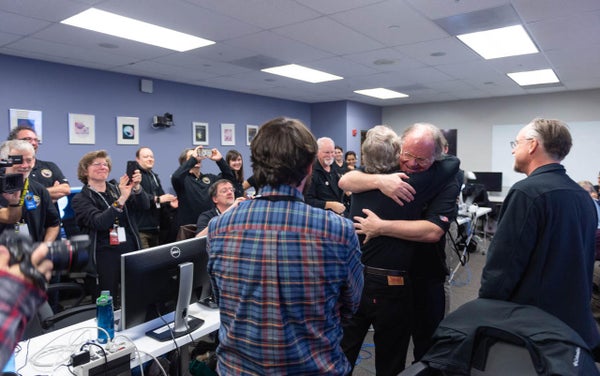
Credit: NASA, JHUAPL, SwRI and Henry Throop
So, I have to hug John, too! But there’s more. Some two years ago, John tasked me to lead the design of the highest-resolution imaging sequences to be done. Whether or not we could target Ultima Thule with the high-res camera on New Horizons was an open question at first. I was always pestering John about one trick or another we might perform to make it all work. And so it did, so it did.
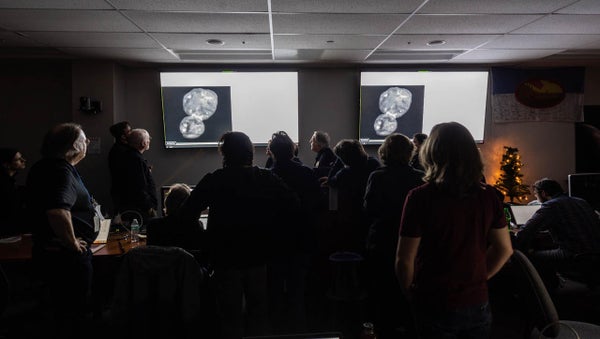
Credit: NASA, JHUAPL, SwRI and Henry Throop
Here’s Ultima Thule! Can you “read” this image? (Full disclosure: here we’re looking at an even closer image that came in much later in the evening, not the first one to come down.) I try to learn from my time with the team, but I am not trained as a planetary scientist. As an extragalactic astronomer, I can read galaxies, star clusters, what have you, but this is beyond my experience. But then, it is beyond everyone else's experience as well, and that is the essence of discovery. I do know that Ultima Thule is nothing like anything we've seen before. Is it special, though? We hope not! We've never been out this far before. The whole Kuiper Belt was unknown until the early nineties. We hope that Ultima Thule is not strange but rather is a typical denizen of a strange new place.
Every team member will look at Ultima Thule differently based on their own experience, intuition, knowledge, influences. We will share all these ideas among ourselves, with various bouts of arguing, jaw-boning, calculating, simulating, gesticulating. We will be wrong about some things, right about others. Clever ideas will emerge, often from those not on the team, but waiting patiently (or waiting not so patiently) to see what we've netted from the outer solar system.
But for now, imagine yourself here with us in the darkened room. Stand quietly, look, think, imagine, reflect on how far we’ve traveled, and what we will learn from the trip. It is your adventure, too.